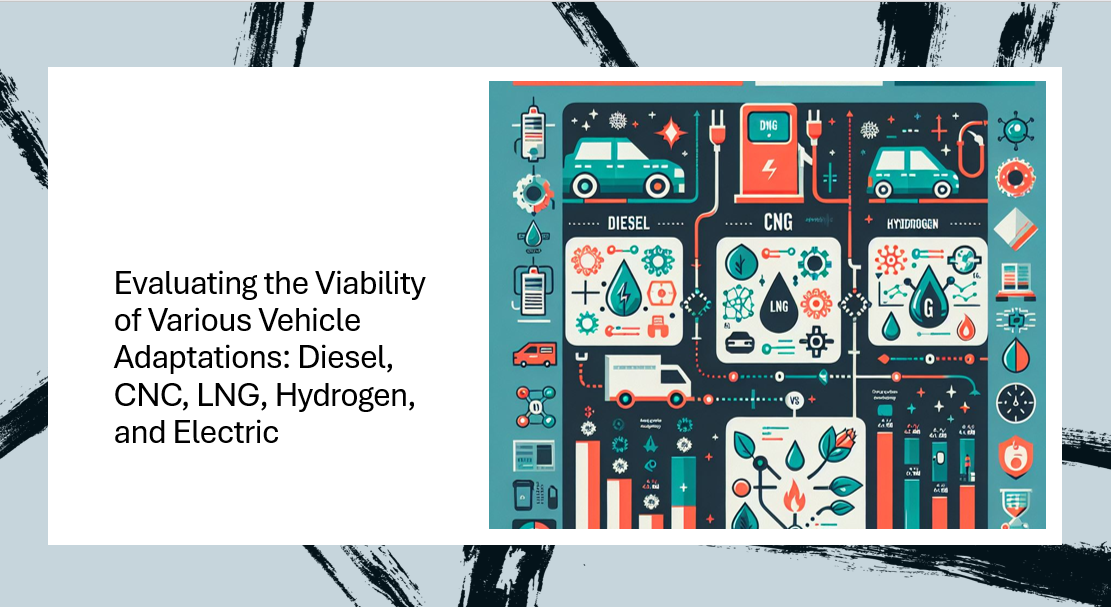Overview of Vehicle Adaptations
As concerns surrounding environmental degradation, economic sustainability, and technological innovation continue to grow, the automotive landscape is undergoing significant transformations. Vehicle adaptations have emerged as essential solutions to address these pressing issues, aiming to reduce carbon emissions and enhance fuel efficiency. The urgency of transitioning towards more sustainable vehicle options has become more apparent, driven by both regulatory measures and shifting public perceptions regarding transportation methods.
Various types of vehicles have been considered for adaptation, each presenting unique advantages and challenges. Diesel vehicles have long been a mainstay in the transportation industry, known for their efficiency and power. However, rising environmental awareness has prompted scrutiny over their emissions, leading to a reevaluation of their role in future mobility solutions.
Another alternative is Compressed Natural Gas (CNC) vehicles, which utilize a cleaner-burning fuel compared to traditional gasoline or diesel. CNC has garnered interest due to its potential to reduce air pollution and greenhouse gas emissions, making it a compelling option following advancements in refueling infrastructure.
Liquefied Natural Gas (LNG) is yet another adaptation gaining traction, particularly in heavy-duty transport sectors. LNG vehicles offer similar benefits to CNC but with greater energy density, potentially leading to longer ranges and lower costs for long-haul transportation.
In recent years, a focus on hydrogen-powered vehicles has emerged, recognized for their ability to produce only water vapor as emissions. This technology, while still in its developmental stages, holds promise due to its sustainability and efficiency. Lastly, electric vehicles (EVs) have gained significant market share, driven by advancements in battery technology and increasing availability of charging infrastructure. The shift towards electric mobility heralds a new era in transportation, aligning with global initiatives aimed at promoting greener alternatives.
The transition to these various vehicle adaptations is also influenced by government regulations and the public sentiment towards sustainability. As society becomes more aware of the environmental impact of traditional vehicles, the embrace of innovative technologies is expected to accelerate, shaping the future of automotive transportation.
In-Depth Analysis of Diesel and CNC Vehicles
Diesel engines have long been a staple in the automotive industry, known for their robustness and fuel efficiency. Their operational mechanism relies on a compression ignition system, which contributes to higher torque levels compared to gasoline engines. Technological advancements have made diesel engines increasingly efficient, allowing for greater fuel economy. This efficiency is measured in terms of miles per gallon (MPG), where modern diesel vehicles can achieve much higher figures than their gasoline counterparts. However, this performance comes with notable drawbacks, particularly regarding emissions. Diesel engines typically produce higher levels of nitrogen oxides (NOx) and particulate matter than gasoline engines, raising serious environmental concerns.
On the other hand, Compressed Natural Gas (CNC) vehicles represent a cleaner alternative. Utilizing natural gas as fuel, these vehicles boast significantly lower emissions, particularly in terms of harmful pollutants. CNC engines emit far fewer NOx and virtually no particulate matter, making them suitable for urban areas striving to improve air quality. The operational mechanism of CNC vehicles is akin to that of gasoline engines, relying on spark ignition. Despite the environmental advantages, the adoption rate of CNC vehicles has been tempered by the availability of refueling infrastructure and the initial costs associated with conversion.
Current statistics indicate a gradual shift towards CNC technology in the commercial vehicle sector, reflecting increased regulatory pressures for cleaner emissions. According to recent reports, diesel vehicles still dominate the heavy-duty segment, accounting for over 80% of freight transport. However, with evolving regulations and procurement policies favoring lower-emission alternatives, the viability of CNC vehicles is gaining traction. Additionally, legal frameworks such as the Clean Air Act in the United States and various European directives are pushing for a reduction in diesel use, thereby influencing market trends towards cleaner technologies. Understanding the strengths and limitations of both diesel and CNC vehicles is essential for stakeholders aiming to navigate the evolving landscape of automotive adaptations effectively.
Exploring LNG, Hydrogen, and Electric Vehicle Technologies
As the automotive industry continues to evolve, alternative fuel technologies such as Liquefied Natural Gas (LNG), hydrogen, and electric vehicles (EVs) are emerging as key players in the quest for sustainable transportation. Each of these technologies presents unique benefits and challenges, shaping the future of mobility.
LNG has gained traction as a bridge fuel, particularly in commercial transportation. It emits fewer greenhouse gases and pollutants compared to traditional diesel fuels, making it an attractive option for fleet operators seeking to reduce their environmental impact. Recent market statistics indicate a steady growth in LNG adoption, with an increasing number of refueling stations being developed worldwide. This infrastructure expansion is essential in facilitating the shift towards cleaner fuels and reducing the reliance on heavier fossil fuels.
Hydrogen, on the other hand, holds immense potential for zero-emission transport, particularly for heavy-duty vehicles and public transport systems. With advancements in fuel cell technology, hydrogen vehicles offer a promising solution to decarbonize sectors that are difficult to electrify. Various countries are investing heavily in hydrogen infrastructure, which includes refueling stations and production facilities. Reports suggest that investments in hydrogen technology are expected to rise significantly in the coming years, driven by the push for net-zero emissions targets.
Electric vehicle technology has evolved rapidly, capturing the attention of both consumers and manufacturers. The growing availability of charging stations, coupled with improvements in battery technology, has led to increased adoption rates of EVs. In addition, various governments are implementing policies to incentivize electric vehicle use, including tax benefits and subsidies, which contribute to a more favorable market environment.
In summary, while LNG, hydrogen, and electric vehicles provide distinct pathways towards sustainable transportation, their integration into the market relies on continued technological advancements and substantial investment in infrastructure. Addressing the challenges each technology faces will be crucial in optimizing their contributions to a sustainable future.
Comparative Analysis and Future Outlook
The transportation sector is undergoing significant transformations with the introduction of various vehicle adaptations, such as diesel, CNC (compressed natural gas), LNG (liquefied natural gas), hydrogen, and electric vehicles. Evaluating the viability of each adaptation requires a comprehensive analysis based on multiple criteria, including sustainability, cost-efficiency, technological infrastructure, and regulatory support.
Starting with sustainability, electric vehicles (EVs) lead the charge owing to their potential for zero-emission operation. However, the environmental impact of battery production and disposal raises concerns. Hydrogen-powered vehicles also provide a viable alternative, emitting only water vapor, yet the current hydrogen production methods often rely on fossil fuels, limiting their sustainability credentials. In contrast, diesel and LNG vehicles present significant emissions, although advancements in engine technologies aim to reduce their ecological footprint.
Cost-efficiency is another critical factor. Diesel engines are typically cheaper to purchase and maintain than electric vehicles, but fluctuating fuel prices can diminish the long-term savings associated with diesel. Electric vehicles, while initially more expensive, are becoming more affordable as battery technology advances and economies of scale come into play. CNC vehicles, on the other hand, are generally praised for their lower operating costs but require investments in specific infrastructure to support refueling, which may deter widespread adoption.
Technological infrastructure plays a vital role in the viability of these adaptations. Electric vehicles benefit from rapidly expanding charging networks, whereas hydrogen refueling stations remain limited. The future of LNG vehicles may depend on the development of more comprehensive refueling infrastructure. Regulatory support also influences the trajectory of these technologies, with governments increasingly promoting electric and hydrogen vehicles through incentives and mandates.
Looking ahead, trends indicate that electric vehicles and hydrogen adaptations may dominate the market due to consumer preferences for sustainability and decreasing costs. While diesel and LNG vehicles will still find niches, businesses and consumers should invest in electric and hydrogen technologies for future-proofing their transportation needs, aligning with government regulations and technological advancements.








Leave a Reply